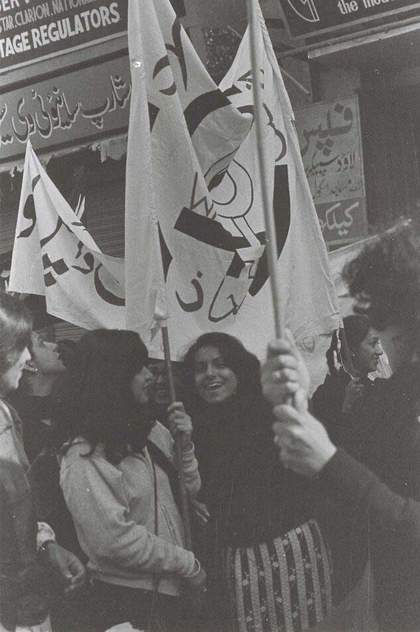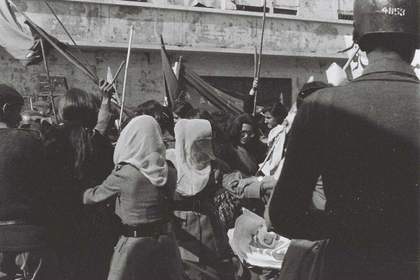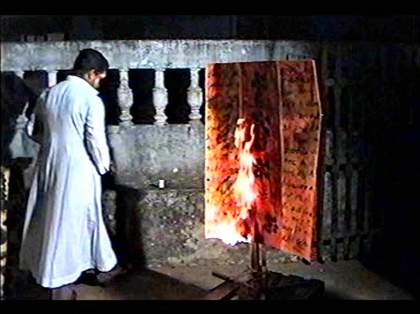On 20 March 1927 Dalit activist and scholar B.R. Ambedkar led a procession of more than ten thousand Dalit protestors to the Chavdar water tank in Mahad. Restricted from touching or drinking the water, Ambedkar reached in and ‘consumed a fistful’. This embodied simple action was a performance of freedom from the caste system. Those accompanying him followed suit.1 Curator Mario D’Souza used this example of the Mahad Satyagraha to launch the seminar Fugitive Forms: Performance in South Asia. Over the course of a day, speakers from Sri Lanka, Pakistan, India and Bangladesh explored how activists and artists have deployed fugitivity and performance to access, sense, dream and define freedoms.

Ghazala Rehman at Women’s Action Forum Protest against proposed Law of Evidence. Mall Road, Lahore, 12 February 1983. Photo: Lala Rukh. Caption: Nighat Said Khan.
Each speaker brought to the table ephemera, memories, art practices or experiences encompassing diverse forms of performance grounded in particular political movements and regional histories. As these archives of performative political practice mingled, co-constitutive, divergent and parallel lineages of activism and artmaking were able to emerge. In conversation, speakers were able to make a small step towards forging what D’Souza called a ‘simultaneous history’ of performance and protest in South Asia. The first panel consisted of D’Souza, activist and artist Salima Hashmi and Sandev Handy, curator at the Museum of Modern and Contemporary Art Sri Lanka.
Hashmi’s audio-visual presentation We Sinful Women involved the consideration of a precious archive; that of the Women’s Action Forum (WAF) in Pakistan, a collective of women artists and activists formed in 1983.2 Photographs taken by artist Lala Rukh transported us to Lahore’s Mall Road, on 12 February 1983, where a peaceful protest was taking place against the newly proposed Law of Evidence. Article seventeen of the law ‘provides that women’s testimony is worth half that of men in certain civil matters’.3 The protest began with a seemingly strange choreography: women walked down the wide road, slowly, two by two. This formation was designed to evade a colonial era law that forbade the gathering of more than four people in a public space. It wasn’t long before the careful, collective movement of the protestors was abruptly broken up. Mall Road erupted as activists found themselves surrounded by police. The photographs in Hashmi’s presentation relayed several of encounters between the police and protestors, who were manhandled, tear-gassed and lathi-charged.

Police action against protestors at the Women's Action Forum Protest against proposed Law of Evidence. Mall Road, Lahore, 12 February 1983. Photo: Lala Rukh. Caption: Nighat Said Khan.
Despite the violence that ensued, Hashmi reflected: ‘I will never forget the sense of absolute freedom running through the main thoroughfare of Lahore.’ Beginning her talk with a reflection on the 1983 protest was important to Hashmi. Reflecting on the space between protest and performance and the transformative nature of passing time within that space, she remarked:
‘The protests only become performances now…the immediacy of what we were protesting against was…so overwhelming that little of it could be planned and orchestrated. We learned that as we went along…for us it was not artwork, it was life…The space between performance and protest keeps altering, it doesn't remain the same.’
With these words, Hashmi insisted that performance practice for the artists in WAF was a life practice. In doing so, she protected the archives, photographs and videos she shared from the danger, in the context of the art museum, of being stripped of the specific urgency of WAF’s fight against the restrictions imposed on women by the military regime of General Muhammad Zia-ul-Haq. ‘The use of music, dance, and performance by WAF was a conscious political act and a reclaiming of public space, an assertion of our bodily autonomy, a pushback against the invisibility imposed on women by the Hudood ordinances as well as the Chadar and the Chaar Diwari,’ Hashmi declared, quoting WAF member Samina Rehman.4 Law of Evidence, a play that was performed in the tradition of street theatre for countless audiences in Pakistan and across the border in India, was the perfect example.
In the video Hashmi shared of the performance, three characters stand on stage. Shoaib Hashmi, who wrote and starred in the play, encounters two female police officers, played by Salima Hashmi and Samena Rana. ‘Are there specific rules for two women who make up one police officer?’, he asks. Hashmi responds: ‘She gets the cap, I get the bell; She gets the shirt, I get the pants…She gets the gun and I get the bullets.’ The audience erupts in laughter. The play goes on to critique in simple yet humorous terms not only the injustice behind the Law of Evidence, but how lacking it was in common sense. ‘Perhaps there was nothing more ridiculous than the notion of two women being the equivalent of one man in the court of law….it begged to be satirised,’ said Hashmi. Poems such as ‘Chadar aur Char Diwari’ (‘The Chadar and the Four Walls’) and ‘Hum Gunahgar Auratain’ (‘We Sinful Women’) by Kishwar Nahid were central to the movement; excerpts of these poems were sprawled across placards and large signs in archival images Hashmi shared of WAF protests. Indian artists participated in and supported WAF’s work. Activist and poet Kamla Bhasin, for instance, wrote and carried a song across the border that Hashmi states ‘became like an anthem’ for WAF members.5 As the seminar progressed, histories of relationships alongside disjuncture, solidarities and strategies of cross-border collaboration against all odds took centre stage.
Several speakers similarly reflected on performance both as a tool and an opportunity for artists to challenge, examine and at times even cross borders. D’Souza shared Bani Abidi’s three-minute short Mangoes 2000. The film depicts two characters, one from India and one Pakistan, both played by Abidi. Expatriates in an unspecified country, they sit side by side at a table covered with a white cloth. Each has a plate, a knife and a mango. In between them is a red basket also laden with the plump fruit. Both characters, while expertly devouring the mangoes, unimpressed, take turns to describe memories of ‘proper’ mango-eating with their families ‘back home’ in India and Pakistan. For both, mangoes appear to represent a sense of belonging; happy memories with cousins, mothers and grandmothers in the summer, watching the rain. They each speak about the difficulty of obtaining mangoes from home – one bemoans how customs officers wouldn't let her cousin carry over a crate, while the other makes a mental note to bring some over on her next trip.
Despite the familiarity of their experiences and their relationship to the fruit and the land it grows on, they refrain from commiserating with one another. This ignorance of an obviously shared cultural context appears incredibly laboured. The distance between them increases slowly, getting more and more strained. Finally, they begin to compete over which country has more varieties of the fruit. ‘It’s an arbitrary, quasi-comic tension’, writes curator Skye Arundhati Thomas, ‘but perfectly representative…much of Indian/Pakistani difference is mediated and maintained by trivial and often untrue, distinctions.’ Abidi speaks to why performance and art-making needs to be deployed to demystify and oppose these fictional distinctions that fuel a historical amnesia and threaten shared histories:
It’s precisely because the making of this border is so recent that we have to move to other forums to oppose it. And this opposition must be a part of a bigger intellectual movement that reminds everyone how young the Indo-Pak border is. As people who have been historically formed through each other, it’s shocking that we are so ready to accept this strange and abstract hatred towards each other.6
The mythical distinctions that are at work in constructing and maintaining a border younger than the grandparents of Abidi’s mango-eaters are disrupted by her skilful satire; the ridiculous nature of the constructed conversation between the two characters exposes the border as not just a ‘physical site of military presence, surveillance and catastrophe’ but as ‘something conjured and retained in the imagination...’ of those on either side.7

Bani Abidi
Mangoes 1999 (screenshot)
© Bani Abidi
The need to move to ‘other forums’ to oppose the erasure of shared histories, articulated by Abidi, is shared by artist Yasmin Jahan Nupur, some of whose work has grappled with the exhaustion, frustration and humiliation that characterise the state of limbo experienced by many Bangladeshi people attempting to travel across the border to India. Nupur’s performances are often silent acts of endurance. She uses both stillness and movement to make her presence speak to the structures she is attempting to contextualise. Through acts of juxtaposition and encounter, she places her body against them. Nupur shared her performance No Man’s Land, her contribution to Britto Arts Trust’s No Man’s Land International Border Project which was organised in collaboration with the Shelter Promotion Council, India from 21-27 March 2014. During her performance, Nupur held onto a white flag for 6 hours in the border region between India and Bangladesh.

Yasmin Jahan Nupur
No Man’s Land 2014
Photo © Munem Wasif
In addition to this and several other performances, Nupur and the Britto cohort coordinated with a group of artists across the border in India. ‘Our aim was to open the border,’ said Nupur, as if it were no big deal. For several hours the two groups searched for one another, calling out and listening for each other’s voices. Their aim was simple: to meet in this no-man’s land. Despite the heavy security at the border and the stringent rules, their relentlessness paid off: ‘at the last moment the BSF (Border Security Force) opened the border and we met together in the no man’s land’, Nupur declared proudly.8
For Hope 2019 Nupur held a sack of seeds weighing sixteen kilos above her head for a total of nine hours. This work, she stressed, was in response to invasive questions she was asked during her Indian visa application process. Through this performance, Nupur challenged the legitimacy of borders and their control over and disruption of natural flows of people, plants and other living things: ‘how do you’ (and perhaps, who are you to) ‘control the seeds?’, she asked. ‘How do you control birds?’ ‘How do you control the sky?’. While No Man’s Land ended with a momentary opening of the borders and a brief meeting between the Indian and Bangladeshi artists who were on either side, did its impact on the border end there? What happens to the political potential of performances when they end? Does it fade away with the pain Nupur described haunting her muscles after the nine gruelling hours of performing Hope 2019?
Sandev Handy, whose presentation grappled with the afterlives of performance art in Sri Lanka, believes otherwise. Handy’s concerns as a curator at the Museum of Modern and Contemporary Art in Sri Lanka reflected the challenges faced by museums tasked with being hospitable to archives of performance and protest. In his presentation, ‘Protesting Bodies and Performing Residues: The Afterlives of Contemporary Performance Art in Sri Lanka,’ co-authored with curator Sharmini Pereira, Handy argued that afterlives of performances are ‘continuously functioning and ideologically active political, social and cultural actors.’
Handy shared Godwin R. Constantine’s 1999 work Broken Palmyrah, performed at VAFA Gallery in Colombo. This is often considered one of the earliest contemporary performance artworks by a Sri Lankan artist. The work was a tribute to Dr Rajini Thirangama, who in 1989 co-authored a book, also titled Broken Palmyrah, that exposed the ‘extreme violence and brutality inflicted at the height of the island’s civil conflict’. On 21 September 1989 Dr Thirangama was killed while cycling home.9

Godwin R. Constantine
Broken Palmyrah 1999 (video still from a performance at VAFA Gallery, Kotte, Sri Lanka, 1999)
© Godwin R. Constantine
Constantine, in response to her death, burned a painting of a broken palmyrah palm. Photographic records of the performance, which took place at VAFA gallery in Kotte in June 1999, have been exhibited in Sri Lanka and have become an important marker in the trajectory of contemporary performance practice. Reflecting on the exhibition of these photographs at the opening of the Museum for Modern and Contemporary art in Sri Lanka, Handy asked:
‘What was the affect that this work produced in those that witnessed it?... Is it limited to a pedagogical reference to us now? Or rather, does it accomplish a historically situated response from which we might address and craft a cannon of art? Perhaps can it help us, like it helped those in attendance to…return to a forgotten communal memory?’
Archives of performances act as signposts in the process of collecting a history of contemporary art in Sri Lanka, a process Handy describes as ‘feeling around in the dark.’ The process of archiving, remembering and looking back at the history of performance art, however, goes beyond the idea of the canon. For Handy, it holds the much more vital possibility of sustaining and reviving communal memory, reviving the feeling of possibility in the performances evoked. As the seminar progressed, performances and their archives or afterlives emerged as tools for collective imagination, action and memory.
Artist Amol K Patil’s offering to the seminar, an hour-long virtual performance and talk, seemed to respond to Handy’s call for a deeper engagement with the political and transformative potential of archives. Patil’s father was an avant-garde playwright and performer and his grandfather a poet. His father’s scripts arose from relationships and conversations with millworkers and sanitation workers in Mumbai, their reflections on the urban landscape and their living and working conditions. The collective sentiment and lived experiences conveyed in his father’s work are still pertinent in the urban landscape of Mumbai today. On a journey of learning Dalit community history through the archives of his family, Patil facilitates a conversation among three generations, responding to his father’s scripts with what he calls ‘archival body language’. This language arises from sections that accompany the margins of the scripts, where his father explains slight expressions, rhythm, movement and delivery. Patil’s performance explored these gestures through slow, restrained and delicate movements of his body in relation to carefully positioned objects.
The second panel focused on histories of grassroots artist collectives that emerged in conjunction with social movements across the region. This panel demonstrated how the diversity and vitality of performance practices in South Asia were as pertinent within the boundaries of nation states as outside of them. Art made with communities ‘is understood [by them],’... ‘it does not have to be explained,’ stated Nupur as she described the work of the Britto Arts Trust, Gidree Bawlee Foundation of Arts and Jog Alternative Art Space and their connection to land, ecological traditions and frameworks of creative collective action. Artists Jagath Weerasinghe and Godwin Constantine spoke about Theertha International Artists Collective in Sri Lanka. Weerasinghe’s talk ‘Against Despair: Performance Art and the “90s Trend”’ explored the performance work of such artists as Constantine, Bandu Manamperi, Janani Cooray and Sivasubramaniam Kajendran. He described the sociopolitical environment that gave rise to Theertha and their work in local communities, with young people, in rural areas as well as the participatory methods they used to develop and run workshops. Madhavi Gore, Nikhil Chopra, Romain Loustau and Shivani Gupta spoke in turn about HH Art Spaces, an international artist residency programme in Goa.
These disparate archives of performance and protest have existed in relation, despite national borders and often in opposition to them. The work of creating and preserving shared histories of performance art in South Asia requires grappling with their specific political contexts while creating interdisciplinary, accessible and transnational openings for engagement.
In order for these relationships to continue, to evolve and have afterlives, spaces for gathering and critically engaging with archives, in all their specificity, gravity, politics and history, through this seminar, emerged not only as essential, but in the face of existing nationalisms and political sentiments across the subcontinent, increasingly urgent.
